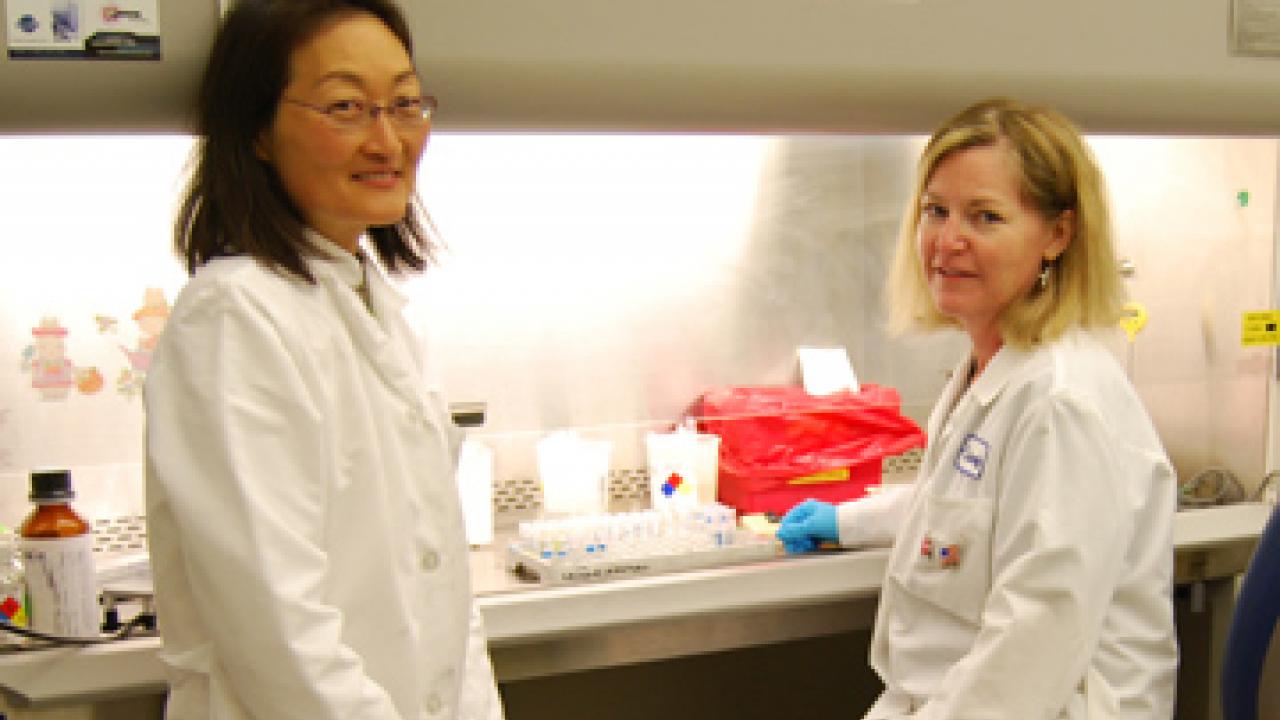Although the combination of apple-green and golden-yellow hues might look lovely in a new spring ensemble, UC Davis clinical lab scientist Rena Kuramoto suspected something was amiss when these colors appeared on slides viewed under her microscope last fall at UC Davis Health System’s Specialty Testing Center.
Kuramoto’s instincts were on the mark. She and fellow clinical lab scientist
Jackie Csicsery were the key people in an investigation by the clinical virology
laboratory that led to a national recall of a product, used in clinical laboratories across the United States, which could have resulted in false positive results for the influenza B virus in respiratory specimens.
“This affected a huge number of laboratories,” said Lynda Braun, supervising
clinical lab scientist. “Had it not been detected by our lab, this defective product could have led to serious consequences for patients.”
Kuramoto’s and Csicsery’s analysis, investigative work and judgment reflect the complexity and importance of the clinical laboratory at UC Davis Health System and other health care institutions. The contributions of these laboratories are celebrated during National Medical Laboratory Professionals Week (this year’s week was April 19 to 25).
The events that led to the recall of the product, called Simulfluor, began with Kuramoto’s examination of a patient’s respiratory specimen. On one slide, Kuramoto was looking for the presence of influenza A and B, while on the second, she was on the lookout for the respiratory synctial virus, or RSV. The specimens on both slides had been treated with Simulfluor, which contains antibodies
to the viruses.
The first slide had cells glowing golden yellow, indicating the presence of influenza B, while the second slide had cells glowing apple green, signifying RSV, a respiratory virus that infects the lungs and breathing passage. The problem?
As Braun explained, “We had samples showing positive tests for two viruses. That could happen, but it’s rare, and usually occurs during the normal flu season
between November and March. And this was in the early fall.”
Suspicious of the dual positive results, Kuramoto sent the samples to the Sacramento County Department of Public Health laboratory for further testing. The county’s tests showed a positive test for RSV only, confirming that Kuramoto’s skepticism was warranted.
Then, last November, Csicsery saw the same, dual-positive results in specimens from two separate patients on consecutive days, Friday and Saturday.
When she did, Braun recalled, Csicsery said, “I don’t believe this. We need to follow up.”
Braun said, “This was highly unusual. We hardly ever see that.”
On the following Monday, Braun called the Simulfluor manufacturer to notify it of her staff’s suspicions that something was amiss with the company’s product. The manufacturer replied that it would investigate and, on Friday, announced that it would recall the faulty product.
The replacement product arrived in a week and a half. During that period, the laboratory staff backed up influenza B results with a viral culture and an algorithm for testing and reporting, implemented by Christopher Polage, medical director of the Microbiology Laboratory. This process prevented reporting erroneous results.
“The excellent detective work and perseverance by our staff was tremendously important not only for our patients, but patients across the country,” Braun said.
Darrell O’Sullivan, chief administrative officer of the Department of Pathology and Laboratory Medicine, said, “We are very proud of the complex, important work our laboratory professionals perform every day.”
David Ong is a senior public information representative for the UC Davis Health System.
Media Resources
Dave Jones, Dateline, 530-752-6556, dljones@ucdavis.edu
